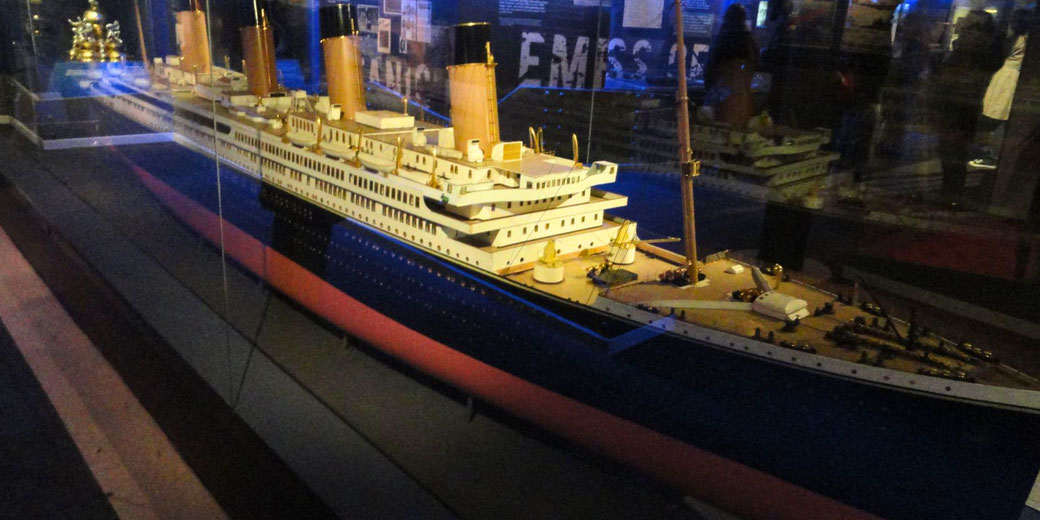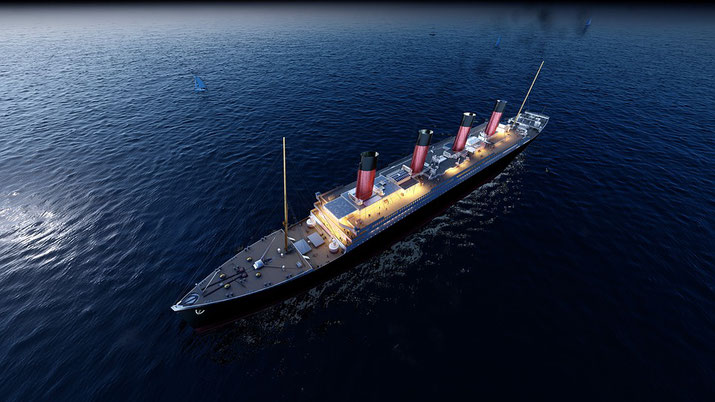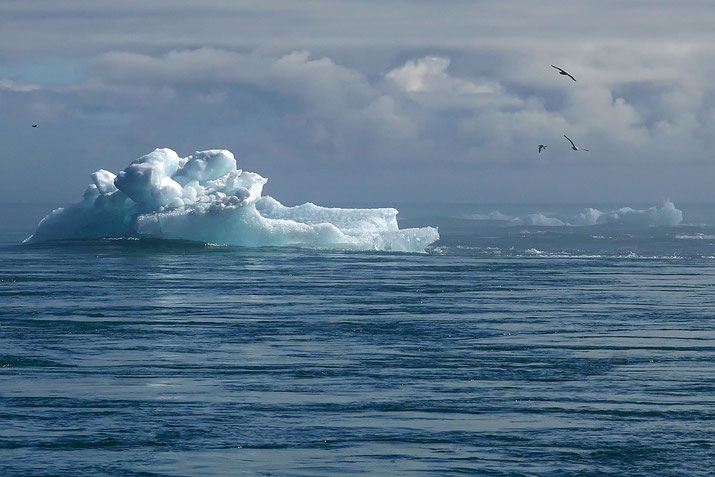Why did the Titanic sink?

The RMS Titanic is one of the most legendary ocean liners of the early 20th century. At the time, it was one of the largest and most luxurious ships ever built: a genuine triumph of modern engineering and design.
But despite its reputation as being practically 'unsinkable', the Titanic is perhaps best known for the horrible tragedy that befell it on April 14, 1912, when it struck an iceberg and disappeared under the waters of the North Atlantic Ocean, claiming the lives of over 1,500 passengers and crew members.
However, this could easily have been avoided. So, who was really to blame for the disaster?
How was the Titanic built?
The original idea for the Titanic was conceived by the White Star Line, a British shipping company, which wanted to build a new class of ocean liners that would be larger and more sophisticated than any that had come before.
The project was led by a man named Bruce Ismay, who was the managing director of the White Star Line.
But he worked closely with Thomas Andrews, a naval architect who oversaw the overall design of the ship.
In fact, the Titanic was the second of three Olympic-class ocean liners built by Harland and Wolff for the White Star Line.
The first of this trio of ships was the RMS Olympic, while the HMHS Britannic was the last built.
For all three craft, Andrews had to develop the detailed blueprints that were passed on to a team of engineers and designers who then created a ship that would be both elegant and functional.
The original plans called for a ship that was 882 feet (269 meters) long, with a maximum beam (width) of 92 feet (28 meters) and a height of 175 feet (53 meters).
One of the most important parts of its design was the requirement that the interior of the structure should be divided into 16 separate compartments.
These were designed to be watertight and could be sealed off in the event of an emergency.
Once the plans were finalized, the ship's construction took place at the Harland and Wolff shipyard in Belfast, Northern Ireland, by a workforce of around 3,000 men.
The entire construction stage of the project would take about three years by the end, with the ship finally being launched on May 31, 1911.
However, it would be another ten months before the Titanic underwent its all-important sea trials on April 2, 1912, as a way to ensure that it was seaworthy and to test its various systems and equipment.
It passed all tests it underwent, including those for speed and maneuverability.
Once the company was happy with the results of the various tests, they focused on finalising the various elements of its lavish interior design in preparations for its first influx of luxury passengers.
To this end, the ship was fitted with its expensive amenities, including an Olympic sized swimming pool, a Turkish bath, and a spectacular grand staircase.
One of the decisions that was made during the fitting-out stage would become a point of contention after the disaster.
Bruce Ismay had decided that the Titanic would only carry a total of 20 lifeboats, which included 2 wooden cutters, 14 standard wooden lifeboats, and 4 collapsible lifeboats.
His decision was actually perfectly acceptable based upon the outdated maritime safety regulations of the era.
Specifically, the Merchant Shipping Act of 1894 required ships over 10,000 tons to only carry a minimum of 16 lifeboats.
The Titanic actually exceeded this standard with its 20. However, Ismay didn't want to have any more than this, because he feared that too many lifeboats would obstruct the sea views for passengers.
This meant that the lifeboats only had a total capacity of about 1,178 people, which was woefully insufficient for the approximately 2,200 passengers and crew expected to be on board.
In reality, it would have needed around 64 boats to save everyone.

Where was the Titanic sailing to?
The time and expense the White Star Line invested into the ship showed how badly they wanted to establish the Titanic as its flagship transatlantic passenger service.
To help in this, they planned the ideal itinerary for its maiden voyage. It was to depart from the port of Southampton in England, and sail to New York City, with stops in Cherbourg in France, and Queenstown (now Cobh) in Ireland.
The entire voyage was intended to generate consistent positive publicity for the company, which it hoped with help it in its competition with other large shipping organisations, such as the Cunard Line.
The first trip was to carry 2224 people, which included 1317 passengers and a large crew of 907.
As the day for the maiden voyage of the Titanic approached, there was genuine anticipation generated by a great deal of media attention thanks to a number of special events and performances which had been arranged by the company.
How the maiden journey began
The maiden voyage of the Titanic finally began on April 10, 1912, when it launched from Southampton, England.
The ship's journey was generally smooth and uneventful for the first few days of the voyage as the passengers enjoyed the various and lavish amenities on board the giant ship.
Many of the passengers spent their days lounging on the ship's decks, taking in the sunshine and fresh air.
Just four days in, on the evening of April 14, the Titanic was sailing in calm waters in the middle of the Atlantic Ocean when it received several warnings about icebergs in the area.
Despite these warnings, the captain of the ship decided to maintain its high speed and course in order to reach New York on time.
Trusting their superior officer, the rest of the crew did not take additional precautions to avoid icebergs either.

What happened on the night the Titanic sank?
Then, at around 11:40 PM, the Titanic suddenly hit an iceberg. It was traveling at a speed of approximately 22.5 knots (about 25.9 mph), nearly its maximum speed, which left little time to manoeuvre and avoid disaster.
The iceberg scraped firmly along the starboard (right) side of the hull, below the waterline.
It caused a series of narrow gashes across about 300 feet (nearly 100 metres) of the forward hull, which damaged six of her sixteen watertight compartments.
The damage was not one continuous cut, but was several smaller punctures, each only about the size of a couple of sheets of A4 paper.
However, collectively, they were enough to flood multiple compartments.
The Titanic was designed to stay afloat if up to four of the compartments were flooded, but the iceberg breached at least five.
By 12:05 AM, the first distress call was sent out via wireless telegraph, which was received by several other ships in the area, including the RMS Carpathia, which was over 60 miles away.
Its captain, Arthur Rostron, immediately changed course and headed towards the Titanic.
The SS Californian, which was only about 10-20 miles away from the Titanic, had already turned off its wireless for the night and didn't receive the messages.
It also failed to respond to the distress flares that were sent up.
While waiting for any nearby ships to come and help, Titanic's captain, Edward Smith, saw how quickly the vessel was going down and reluctantly gave the order to abandon ship.
As they had been trained to do, his crew worked quickly to assist passengers in evacuating the vessel.
However, since there were not enough lifeboats, many passengers and crew knew that they were to be left stranded on the rapidly sinking ship.
As the ship progressively began to tilt further and take on more water, the crew began launching the lifeboats even if they were not filled to capacity.
In fact, some were launched with only a few passengers on board, with dozens of empty spaces that could have been used to save many more lives.
All the while, the two wireless operators, Jack Phillips and Harold Bride, worked tirelessly to send distress signals using the Marconi wireless system, even continuing to transmit until water flooded their compartment.
As the ship continued to sink, the scene grew increasingly chaotic. The ship's band played music to try and help to calm the passengers and maintain a sense of order.
But this did little to dampen the sounds of screaming, crying, and chaos in the air as substantial sections of the ship began to disappear beneath the waves.
Finally, at around 2:20 AM, just two hours and forty minutes after the collision, the Titanic finally sank beneath the surface of the ocean forever.
Many passengers and crew were still on board, while those in the water or on lifeboats faced hours of exposure to extreme cold.

Many passengers tried to help those in the water if they could, or even offering comfort and assistance to those in the boats who were calling into the dark night for loved ones they had been separated from.
Eventually, the Carpathia arrived on the scene at around 4.00am and began rescuing survivors from the lifeboats shortly after.
Since it was still very early in the morning, they had to use spotlights to search for those in need of help.
Despite their best efforts, over 1,500 people lost their lives in the sinking of the Titanic. Even to this day, it is one of the deadliest maritime disasters in history.
That meant that only 706 survived the sinking, with a disproportionate number of those from first-class passengers compared to those in lower decks.
The Titanic’s Captain Smith chose to go down with the ship, which was considered a heroic decision.
In contrast, Bruce Ismay was criticized for surviving the disaster by escaping in a lifeboat while so many others perished.
In a sad irony, Thomas Andrews, the chief designer of the Titanic, was aboard the ship during its maiden voyage and perished in the sinking.
He was last seen on board the ship during its final moments, reportedly helping others to safety and ensuring passengers were evacuated.
What happened after the sinking?
After the sinking of the Titanic, there were immediate efforts to investigate the disaster and to provide assistance to survivors and the families of those who had perished.
The survivors of the sinking were taken to New York City aboard the Carpathia.
Many of them had lost loved ones in the disaster, and the trauma of the experience would stay with them for the rest of their lives.
Meanwhile, a formal investigation into the sinking was launched by both the United States and British governments.
In America, the inquiry was led by the United States Senate, while in the UK, it was the British Board of Trade.
Each group sought to determine the cause of the disaster and to assess whether any negligence or misconduct had occurred.
The investigations revealed a number of factors that had contributed to the sinking, including the failure to have enough lifeboats on board and the inadequate training of crew members.
Nevertheless, the inquiry led to significant changes in maritime law, including the requirement for sufficient lifeboats for all passengers, 24-hour radio watch on ships, and the establishment of the International Convention for the Safety of Life at Sea (SOLAS) in 1914.
Also, in response to the Titanic disaster, the International Ice Patrol was established in 1914 to monitor iceberg dangers in the North Atlantic.
This service still continues to this day and is operated by the United States Coast Guard.
What caused the sinking?
Ultimately, one of the main reasons the Titanic sank was because it was traveling too fast in an area where there were known to be icebergs.
As mentioned earlier, Captain Smith had received several warnings about the presence of ice in the area, but he chose to not take the necessary precautions.
So, when the Titanic finally did spot the iceberg, it was too late to avoid a collision.
In addition, there were issues with the design and construction of the Titanic itself.
The ship's watertight compartments were not designed to withstand the massive flooding that occurred after the collision with the iceberg.
Taken together, these factors all played a role in the sinking of the Titanic.
How the wreck of the Titanic was found
The wreck of the Titanic was eventually rediscovered in 1985, almost 370 miles south-southeast of Newfoundland by a joint American-French expedition, which was led by Dr. Robert Ballard.
At the time, the Titanic had been lost at sea for over 70 years, and many people believed that the wreck could never be found.
To achieve this feat, Ballard's team used a remotely operated vehicle (ROV) to search the ocean floor for the Titanic.
It was equipped with a camera system that could transmit images back to the surface in real time, which crucially allowed the team to carefully explore the ocean floor.
After several days of searching, the team finally located the Titanic's wreckage on September 1, 1985, at a depth of approximately 12,500 feet (3,800 meters) below the surface of the ocean.

Since the rediscovery, there have been a number of expeditions to explore the site further, and to study the ship and its surroundings in greater detail.
As a result, these expeditions have yielded a wealth of information about the Titanic which have helped explain the events that led to its sinking.
Perhaps one of the most significant discoveries made at the wreck site was the fact that the Titanic had broken in two during the sinking.
In fact, the bow and stern sections of the ship were found separated by a distance of about 2,000 feet (610 meters).
In addition, countless miscellaneous artifacts have been recovered from the Titanic's wreckage, including personal belongings of passengers and crew members, as well as items related to the ship's operation and maintenance.
For many people, it is these artifacts that have helped to bring the story of the disaster to life in the many travelling exhibitions which allow the modern public to view the items and hear the tragic story of the tragic final journey of their owners.
What do you need help with?
Download ready-to-use digital learning resources
Copyright © History Skills 2014-2025.
Contact via email
With the exception of links to external sites, some historical sources and extracts from specific publications, all content on this website is copyrighted by History Skills. This content may not be copied, republished or redistributed without written permission from the website creator. Please use the Contact page to obtain relevant permission.





